AMMAN — On June 18th, Sustainable Gastronomy Day was
commemorated with a remarkable event at the Royal Academy of Culinary Arts,
where four renowned chefs from different regions of the Kingdom assembled. The
gathering, organized by Hospitality in Health, aimed to honor this annual
occasion with a captivating four-course dinner entitled "From Farm to Fork
in Jordan."
اضافة اعلان
Each dish served during the dinner carried its own unique narrative,
including the very plates they were presented on, even the plates on which the
first dish of the evening was served celebrated artisanal pottery made by the
local women's community of Iraq al-Amir.
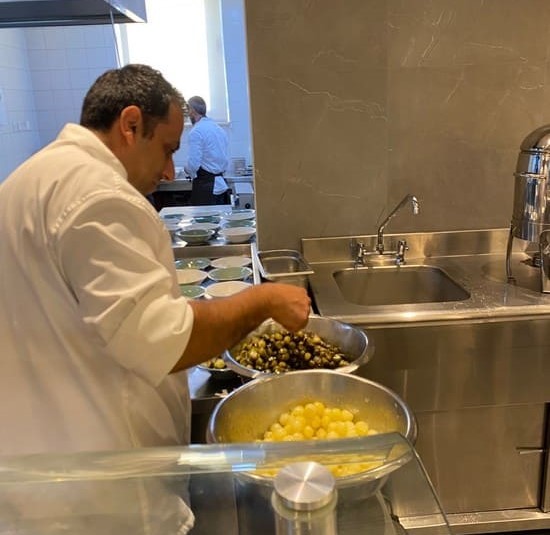 (Photo: Sarah Shabbar)
(Photo: Sarah Shabbar)
Celebrating local chefs, vendors, and the foodies who love
to see them strive, everything served throughout the evening was a constant
reminder of how purposeful eating is essential to the future of gastronomy.
All key ingredients on the menu were 100 percent local,
seasonal, and sourced from 11 different Jordanian suppliers. And channeling my
inner Chandler Bing, I thought: “Could this be any more local?”
So, let us dig in. I thankfully got to sit at the most interesting table, in my
humble opinion, of the evening and break upcycled bread (literally) with some
of the evening’s vendors.
 (Photo: Sarah Shabbar)
(Photo: Sarah Shabbar)
Amelia Bilbeisi from Maida Olive Oil shared insights about
one of the Kingdom’s most beloved ingredients and the local scene of olive oil
overall. Her farm, located in the central desert region of Jordan, grows five
varieties of cultivators and picks and presses within hours in its onsite mill.
Bilbeisi, an olive oil sommelier, highlighted how this small yet mighty
ingredient is one of the most important aspects of piecing together a dish.
As we dipped upcycled bread in her Arbosana blend, we waited
eagerly to see how each chef would take on each dish of the night and what
would be the star ingredient in each course.
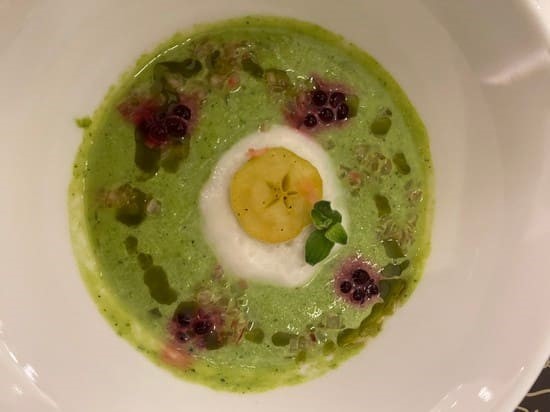 (Photo: Sarah Shabbar)
(Photo: Sarah Shabbar)
Meanwhile, to my left sat Ahmad Dweikat from Cuts — the only
full-blood Wagyu breeder in the region. He highlighted even the small practices
of sustainable meat in the Kingdom, something often overlooked when dug deep
into shows a bigger need for humane, sustainable practices when it comes to
meat.
As the founder of HIH, Nicolas Dingemans prompted us to open
our phones, the evening's menu prevailed, and the first dish was unveiled.
First course: A homage to the bounty of herbs in the Kingdom
The first course was served by Chef Sara Aqel, who focused
on the socio-economic impact with a salad that included pickled onions, basil,
mint, fennel, mulberry, and green herbs, all sourced from local farms. Her
dish, served in the aforementioned local artisanal pottery, was super fun to
eat, to say the least.
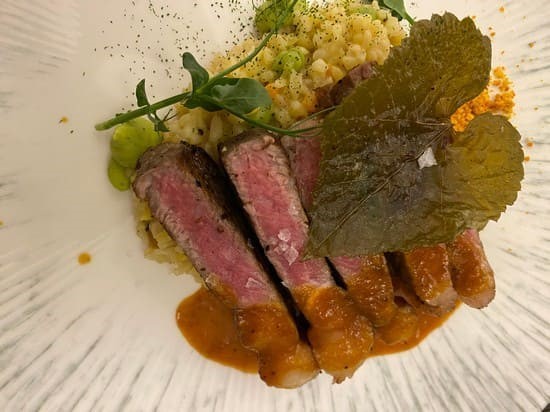 (Photo: Sarah Shabbar)
(Photo: Sarah Shabbar)
Each ingredient, each of the same size, and the aromatic
herbs was her homage to how even the most looked over ingredients are truly
stars. She said, “I used herbs which can be found everywhere in Jordan, even on
the sidewalks, while I travel a lot; since I have been back in Amman, I have
not had to buy these ingredients; they can be found everywhere.”
Also, if you did not know, now you know that, according to
Aqel, “lemon zest is the Chanel for food.”
Second course: No more food waste
If you’re a Weibdeh native or local, you have probably
walked by multiple times or even enjoyed eating at Joz Hind. If you are like
me, a local to the neighborhood, you might have even had the pleasure of
walking by in the morning and watching Chef Luca Lelli blast metal music while
prepping ingredients for the day.
His dish, focused on innovation and no waste, was a chilled
plant-based soup with baby apple, pickled radish, and beetroot caviar. As he
explained it as a touch-and-eat dish, touch your spoon, put it in your mouth,
savor, and repeat.
With a whipped white cheese foam on top, each color paired
beautifully with red, white, and green as an ode to the Kingdom’s flag, while
unintentional, was super cool.
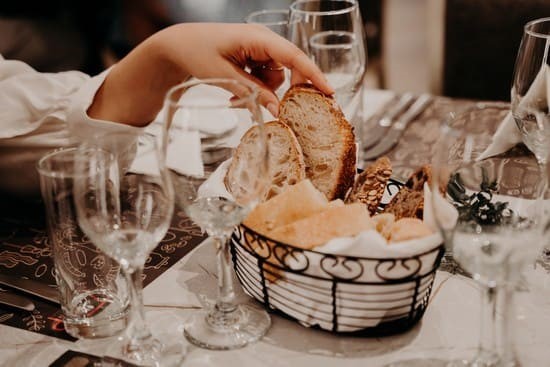 (Photo: Jude Al-Safadi)
(Photo: Jude Al-Safadi)
The dish was a reminder of how you can easily break up the
tradition, even on soups.
Just as Lelli lives outside of the box, eating a chilled
soup on quite a hot day might even be your next inspiration for what you can do
to create a no-waste meal when you need to clean out the fridge.
Third course: An ode to the Jordanian household
The third course, served by Chef Mohammad Atieh, MBC Top
Chef finalist and Executive Chef of W Amman, focused his main dish on many ingredients
that can be found in a Jordanian household and the way he symphonized them
together in a medley of flavors was admirable.
The main course featured the star ingredients, grilled halal
Jordanian Wagyu striploin beef, bulgur, roasted hamlet, grape leaf chips, red
grape tamarind BBQ sauce, and carrot ginger crumble. Atieh said, “It is a dish
you can make at home.” While his sentiment is sweet, it might be a bit
ambitious.
While it may not be a dish everyone can make at home, it
plays beautifully to how home is the first place where we learn our love for
food and our palettes. The red grape tamarind BBQ was a refreshing taste to the
overused pomegranate molasses in Levantine cuisine.
Fourth course: Food is political
The fourth dish was the star of the night. As Chef Aya
Alqour, from Aya Elite Patisserie, came out to introduce her dish, she carried
an empty plate that resembled an embroidery hoop, and the wonder and the awe of
each guest amplified.
Her dish, which was refined sugar-free, was an absolute
creative masterpiece and a reminder that even food can be political. As the
dish came out, the top was coated with a black layer of dark chocolate and the
red "Tatreez" design. Underneath the edible "Tatreez" laid
an organic peach clafoutis with a sugar-free salted honey brown butter caramel.
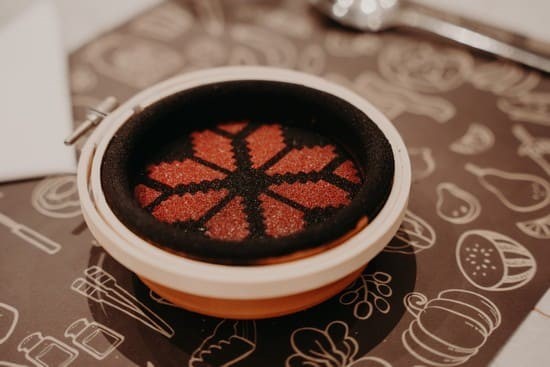 (Photo: Jude Al-Safadi)
(Photo: Jude Al-Safadi)
A hat off to her grandmother, and maybe even an unintended
nod to the current world we live in and the Palestinian occupation, the dish
was perhaps another way of asserting tradition in a beautifully masterful way.
Where the idea all started
As the evening went on, the conversations and laughter grew,
the events were organized, and founder, Dingemans shared his love for the
culinary arts, especially when it comes to supporting Sustainable Culinary
Tourism.
With tradition preserved, and innovation invited, Dingemans
told
Jordan News about how his idea started and why Jordan was its
home. “It all started with culinary tourism, and Jordan has the perfect
foundation to take the reins in being one of the leaders of culinary tourism in
the region.”
And his methodology for building culinary tourism remains
through three pillars: ingredients, the farmer, and the chef.
Then, in a small and delicious package, it is brought to use
by the consumers, food lovers, and wanderers with him, leaving his final note,
“One ingredient can share hundreds of stories.”
Read more Good Food
Jordan News



